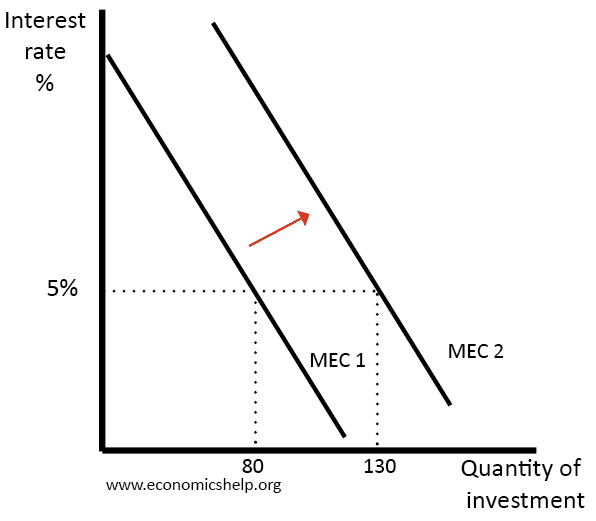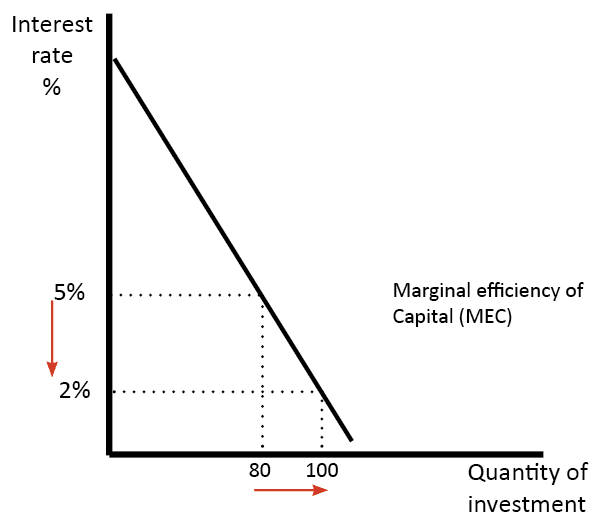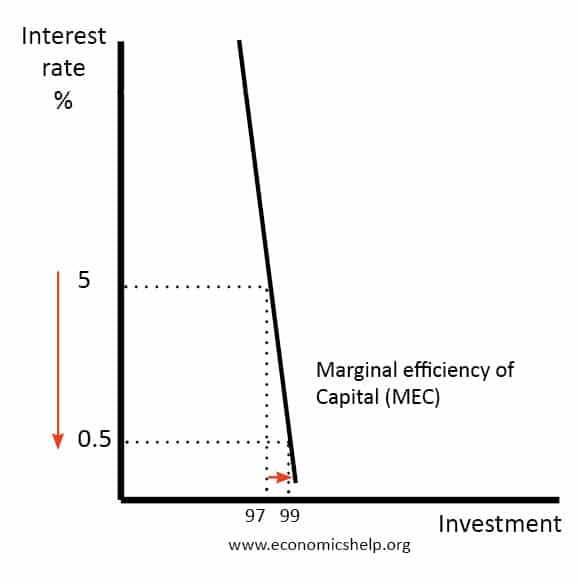The marginal efficiency of capital displays the expected rate of return on investment, at a particular given time. The marginal efficiency of capital is compared to the rate of interest.
Keynes described the marginal efficiency of capital as:
“The marginal efficiency of capital is equal to that rate of discount which would make the present value of the series of annuities given by the returns expected from the capital asset during its life just equal to its supply price.” – J.M.Keynes, General Theory, Chapter 11
This theory suggests investment will be influenced by:
- The marginal efficiency of capital
- The interest rates
Generally, a lower interest rate makes investment relatively more attractive.
If interest rates, were 3%, then firms would need an expected rate of return of at least 3% from their investment to justify the investment.
If the marginal efficiency of capital was lower than the interest rate, the firm would be better off not investing, but saving the money.
Why are interest rates important for determining the marginal efficiency of capital?
To finance investment, firms will either borrow or reduce savings. If interest rates are lower, it’s cheaper to borrow, or their savings give a lower return making investment relatively more attractive.
Marginal Efficiency of Capital
- A cut in interest rates from 5% to 2% will increase investment from 80 to 100.
- The alternative to investing is saving money in a bank; this is the opportunity cost of investment.
If the rate of interest is 5%, then only projects with a rate of return of greater than 5% will be profitable.
How responsive is investment to interest rates?
In Keynesian investment theory, interest rates are one important factor. However, in a liquidity trap, investment may be unresponsive to lower interest rates. In some circumstances, demand for investment is very interest inelastic.
In a liquidity trap, business confidence may be very low. Therefore, despite low-interest rates, firms don’t want to invest because they have low expectations of future profits.
Factors which shift the marginal efficiency of capital

Factors that can affect investment schedule
1. The cost of capital. If capital is cheaper, then investment becomes more attractive. For example, the development of steel rails made railways cheaper and encouraged more investment.
2. Technological change. If there is an improvement in technology, it can make investment more worthwhile.
3. Expectations and business confidence. If people are optimistic about the future, they will be willing to invest because they expect higher profits. In a recession, people may become very pessimistic, so even lower interest rates don’t encourage investment. (e.g. during recession 2008-12, interest rates were zero, but investment low)
4. Supply of finance. If banks are more willing to lend money investment will be easier.
5. Demand for goods. Higher demand will increase the profitability of capital investment.
6. The rate of Taxes. Higher taxes will discourage investment. Sometimes, governments offer tax breaks to encourage investment.
Related


